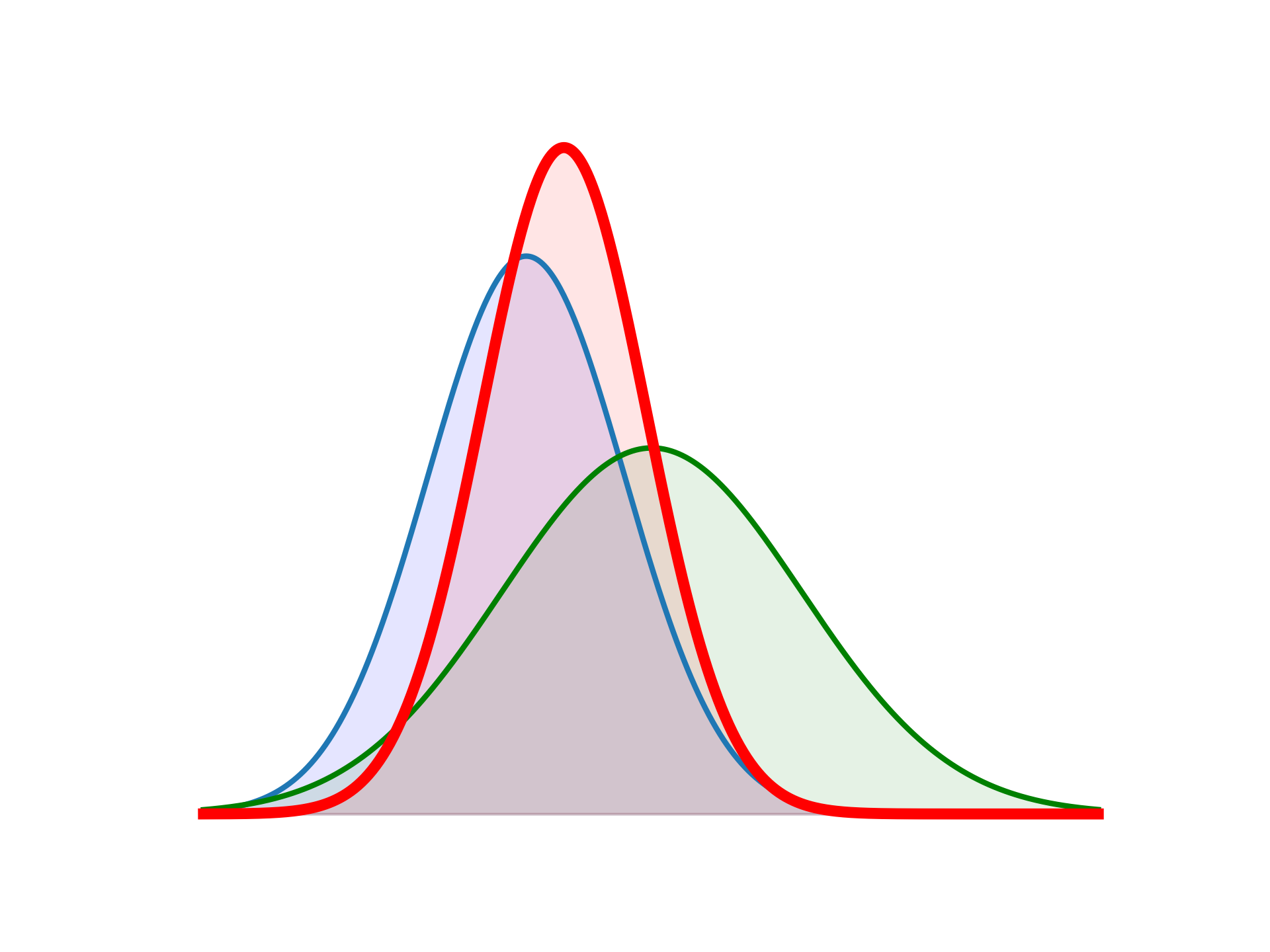Before introducing more general nonlinear dyanmic systems (see the following examples), let us consider a simple case of tracking a random sine signal whose angular velocity and amplitude vary, randomly, over time. We express the nonlinearity through the measurement model, though this could be done with the dynamic model, as in the examples below.
Let the state vector be
\[
\mathbf{x}_k = \left[\begin{array}{c}
\theta_k\\
\omega_k \\
a_k
\end{array}\right],
\]
where the \(\theta\) is the angle, \(\omega\) the angular velocity and \(a\) the amplitude of the sine function. The model is then
\[\begin{align}
\frac{\mathrm{d} \theta}{\mathrm{d}t} &= \omega \\
\frac{\mathrm{d} \omega}{\mathrm{d}t} &= w_{\omega}(t) \\
\frac{\mathrm{d} a}{\mathrm{d}t} &= w_a(t)
\end{align}\]
In matrix form, we have
\[
\frac{\mathrm{d}\mathbf{x}}{\mathrm{d}t} = F \mathbf{x}(t) + L \mathbf{w}(t) , \quad \mathbf{x}(0) = \mathbf{x}_0,
\]
where
\[
F = \begin{bmatrix} 0 & 1 & 0\\ 0 & 0 & 0 \\ 0 & 0 & 0 \end{bmatrix}, \quad
L = \begin{bmatrix} 0 & 0\\ 1 & 0 \\ 0 & 1 \end{bmatrix}, \quad
\mathbf{w}(t) = \begin{bmatrix} w_\omega (t)\\ w_a(t) \end{bmatrix},
\]
and the power spectral density of the white noise process \(\mathbf{w}(t)\) is
\[
Q^c = \begin{bmatrix} q_1 & 1\\ 0 & q_2 \end{bmatrix}.
\]
Using the matrix exponential formulas (see KF-tutorial), we get the discrete system
\[\begin{align}
\mathbf{x}_{k+1 } &= A_k \mathbf{x}_{k} + \mathbf{q}_{k}, \\
y_k &= a_k \sin \theta_k + r_k
\end{align}\]
where \(r_k \sim \mathcal{N}(0, \sigma_r)\) is univariate Gaussian noise,
\[
A_k = \begin{bmatrix} 0 & \Delta t & 0\\ 0 & 1 & 0 \\ 0 & 0 & 1 \end{bmatrix},
\]
and \(\mathbf{q}_{k} \sim \mathcal{N}(0, Q_k)\) with
\[
Q_k = \begin{bmatrix} q_1 \Delta t^3 / 3 & q_1 \Delta t^2 / 2 & 0 \\
q_1 \Delta t^2 / 2 & q_1 \Delta t & 0 \\
0 & 0 & q_2 \Delta t \end{bmatrix}.
\]
Finally, the Jacobian of \(h(\mathbf{x}_{k}) = a_k \sin \theta_k\) is easily seen to be
\[
Dh_k = [ a_k \cos \theta_k \quad 0 \quad \sin \theta_k ]
\]
Asch, Mark. 2022.
A Toolbox for Digital Twins: From Model-Based to Data-Driven. Philadelphia, PA: Society for Industrial; Applied Mathematics.
https://doi.org/10.1137/1.9781611976977.
Asch, Mark, Marc Bocquet, and Maëlle Nodet. 2016.
Data Assimilation: Methods, Algorithms, and Applications. Philadelphia, PA: Society for Industrial; Applied Mathematics.
https://doi.org/10.1137/1.9781611974546.
Calvello, Edoardo, Sebastian Reich, and Andrew M. Stuart. 2022.
“Ensemble Kalman Methods: A Mean Field Perspective.” arXiv (to appear in Acta Numerica 2025).
http://arxiv.org/abs/2209.11371.
Carrillo, J. A., F. Hoffmann, A. M. Stuart, and U. Vaes. 2024a.
“Statistical Accuracy of Approximate Filtering Methods.” https://arxiv.org/abs/2402.01593.
———. 2024b.
“The Mean Field Ensemble Kalman Filter: Near-Gaussian Setting.” https://arxiv.org/abs/2212.13239.
Dashti, Masoumeh, and Andrew M. Stuart. 2015.
“The Bayesian Approach to Inverse Problems.” In
Handbook of Uncertainty Quantification, edited by Roger Ghanem, David Higdon, and Houman Owhadi, 1–118. Cham: Springer International Publishing.
https://doi.org/10.1007/978-3-319-11259-6_7-1.
Huang, Daniel Zhengyu, Jiaoyang Huang, Sebastian Reich, and Andrew M Stuart. 2022.
“Efficient Derivative-Free Bayesian Inference for Large-Scale Inverse Problems.” Inverse Problems 38 (12): 125006.
https://doi.org/10.1088/1361-6420/ac99fa.
Iglesias, Marco A, Kody J H Law, and Andrew M Stuart. 2013.
“Ensemble Kalman Methods for Inverse Problems.” Inverse Problems 29 (4): 045001.
https://doi.org/10.1088/0266-5611/29/4/045001.
Law, Kody, Andrew Stuart, and Konstantinos Zygalakis. 2015.
Data Assimilation: A Mathematical Introduction. Vol. 62. Texts in
Applied Mathematics. Cham: Springer International Publishing.
https://doi.org/10.1007/978-3-319-20325-6.
Sanita Vetra-Carvalho, Lars Nerger, Peter Jan van Leeuwen, and Jean-Marie Beckers. 2018.
“State-of-the-Art Stochastic Data Assimilation Methods for High-Dimensional Non-Gaussian Problems.” Tellus A: Dynamic Meteorology and Oceanography 70 (1): 1–43.
https://doi.org/10.1080/16000870.2018.1445364.
Särkkä, S., and L. Svensson. 2023.
Bayesian Filtering and Smoothing. 2nd ed. Institute of Mathematical Statistics Textbooks. Cambridge University Press.
https://doi.org/10.1017/9781108917407.
Wu, Jin-Long, Matthew E. Levine, Tapio Schneider, and Andrew Stuart. 2023.
“Learning about Structural Errors in Models of Complex Dynamical Systems.” https://arxiv.org/abs/2401.00035.
